Creating unique concrete therapy pools
by Sally Bouorm | June 1, 2011 3:39 pm
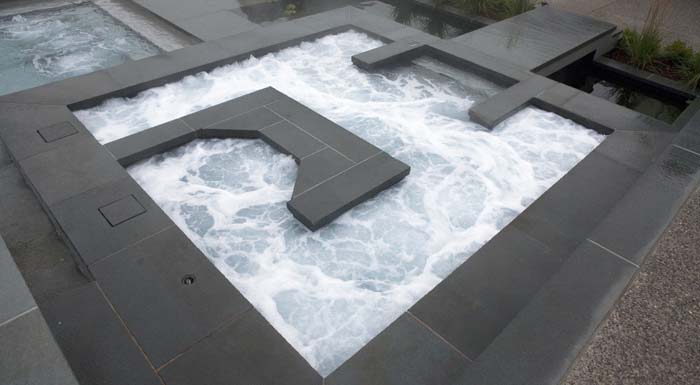 [1]
[1]By Barry Justus
Contractors have a variety of options when it comes to designing and installing spas—from custom-built stainless steel, copper and concrete (cast-in-place and shotcrete) units to portable models. Generally, budget, deadlines and skill set influence design decisions for custom spas, while off-the-shelf units typically cost less and take little time to install. This article will focus on designing and installing concrete spas.
Concrete offers builders flexibility
Custom concrete spas offer an enormous amount of design flexibility. Their size, shape and design are limited only by the site architect’s imagination. From single-person plunge spas and large commercial party spas to highly sophisticated perimeter overflow basins with complex hydraulics and exotic interior finishes, the main design parameter for every project should be balancing esthetics with practicality.
Location, location, location
The spa’s location is the obvious place to start the design. It can be located in, adjacent to or separate from the pool. In all cases, however, it is possible to configure the spas’ plumbing and heating to share the pool water or be built as a separate entity. Another option is to install a rill or runnel (a functional constructed channel that carries a water supply from a water source some distance away), which would link the spa to the pool. This feature allows them to share filtered water, while creating an additional architectural design element on the property.
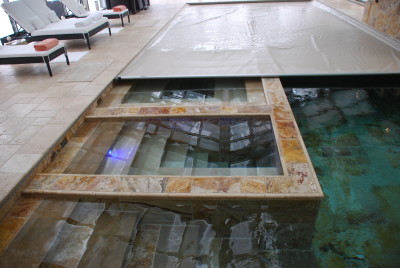 [2]
[2]In northern climates, the spa is often located a few steps from the home, if winter use is intended. This may involve installing heating coils in the deck and a pathway to allow unlimited access to the spa. The spa’s fill lines should be located below the frost line and protected from freezing in the spa itself.
Care must also be taken to avoid placing an elevated spa in a position that blocks site lines into the pool. It is common practice to place a raised spa at the entrance to a long pool; however, this can block the view of children swimming in the pool from the deck. The advent of 3-D design software has eliminated many potential pitfalls with regards to line of site and safety in the aquatic environment.
While not a common practice, positioning the spa inside the main body of the pool has some advantages. Not only is it less expensive to construct compared to a stand-alone or poolside spa, it becomes possible to cover both bodies of water with a single automated cover, which saves money and energy.
| LIGHTING: ENHANCING THE SPA EXPERIENCE |
|---|
| The options for spa illumination are almost endless. Lighting can be used around the spa’s perimeter and interior (e.g. foot well and spa jets), as well as to highlight certain features such as waterfalls. A variety of effects such as fades, mode and accent lighting in addition to programmable patterns can also be incorporated into a spa’s lighting schematics. The following is a guide to the pros and cons of the three main types of lighting systems available for spas: 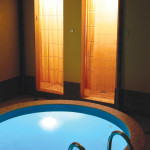 [3] [3]Incandescent lights 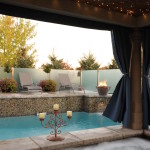 Fibre-optic lighting 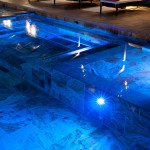 [4] [4]Light emitting diode (LED) lighting No matter what illumination system is being used, the spa lighting experience starts at the automation touch pad inside the client’s home. From this control centre, one-touch programming allows the mood to be set. The spa is heated, jets are turned on, stereo system is enabled and a subtle illuminated path guides the bather to the spa. As they relax after a hard day’s work, they look up to the overhead starlight, push a button and flames spring to life in a nearby water feature. |
In a ‘spa’ shell
In addition to the customization benefits, concrete spa shells also pose some construction challenges, as they often contain a large amount of polyvinyl chloride (PVC) plumbing, skimmers, drains and reinforcing bar packed into small areas.
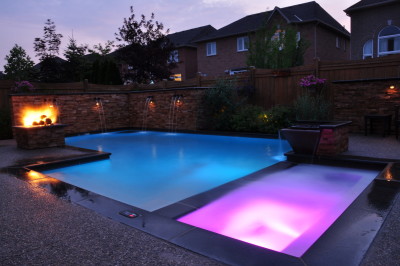 [5]
[5]All reinforcement bars and plumbing lines must be tied securely in place before the shotcrete or cast-in-place concrete pour begins. Furthermore, a skilled concrete-nozzle operator is required to avoid shadows and shooting in confined spaces, such as foot wells or standup wells.
In all cases, concrete spas should also be waterproofed. Waterproofing admixes can be added to the concrete mix or applied to the finished shell. The combination of pressure testing all plumbing lines and flood testing the shell could prevent a potential disaster.
The interior of the spa shell can also be finished in a number of ways. The most common method is standard marbelite or pool plaster. High temperatures and harsh water chemistry conditions found in spas shortens the lifespan of plaster. The best choice for contractors is to tile the spa’s interior, or use another option such as natural stone, porcelain or glass. Even though these finishing materials can be more costly, they will standup to the spa environment.
Concrete spas can be illuminated with light-emitting diode (LED), fibre-optic or standard 12-volt lighting. Keep in mind, however, lighting the path to the spa is just as important as the interior spa lights. Automating the nighttime lighting can also contribute to both safety and ambience of the hot water bathing experience.
Other accessories such as stereo systems, built-in televisions, phones, flame effects, misting systems, acrylic viewing panels, perimeter overflows and vanishing edges can all be tailored for any concrete spa.
Check out the plumbing
One aspect of spa design separating the simple from the spectacular is the configuration of the spa’s plumbing and hydraulics.
When it comes to plumbing, some companies tend to stick with designs that are tried and true, i.e. five simple jets, a single two-speed pump and a venturi have become commonplace.
One way builders can make their concrete spa installations more unique is to attend courses and seminars on plumbing and hydraulics. Several plumbing and equipment manufacturers offer free courses, while another option is to attend a pool and spa educational school to obtain more information. Armed with some basic hydraulic design principles, builders can break the mould and create more exotic spas with multiple jet pumps, an increased number of strategically placed jets and various levels of hydrotherapy.
Basic principles in spa hydraulics include:
- Start with jet placement and flow rates;
- Balance flow via pressure loops and manifolds;
- Number of jets multiplied by flow rate equals the total litres/gallons per minute (lpm/gpm);
- Water velocities and flow rates determine pressure loop size, e.g. if velocity doubles, head loss quadruples;
- Total head loss (friction, fittings, filters, heaters);
- Suction-side velocities should not exceed 1.4 metres per second (mps) (4.5 feet per second [fps]);
- Pressure-side velocities should not exceed 2 mps (6.5 fps);
- Suction lines are larger than pressure lines;
- Install all air lines in a Hartford Loop (above the waterline) to prevent water from backing into the blower;
- Larger lines carry more water at a lower velocity, thus lowering total head loss; and
- All pumps should be supplied by a minimum of two legal suction ports.
What to do about jets and blowers?
Multiple jet pumps result in multiple suction ports, which can become challenging to locate in a smaller spa. One option is to locate a well under one of the benches or stairs where access to suction ports is restricted. The Virginia Graeme Baker Pool and Spa Safety Act (VGBA) has led to a number of manufacturers creating large flow suction ports with a host of anti-entrapment features suitable for the confined spaces in a typical spa.
The idea of adding an air blower to the spa is also often debated. Spa jets are generally designed to operate without an external blower by venturi action. The addition of a forced air blower into the spa jet creates an increased amount of ‘action’ in the spa. Visually, the spa comes alive due to the increased air volume; however, air blowers tend to lower the spa’s water temperature, especially in the winter when cold outside air is injected into the water stream.
If not placed correctly, jets and blowers located on seats and benches can also float bathers out of the spa. Therefore, it is important to locate the air holes and jets properly. This is another advantage to building a custom-concrete spa, as jet placement can be uniquely customized to suit an individual bather.
For example, if the client has a shoulder injury, spa jets can be clustered to target that specific muscle group. Taking measurements of the client’s body, and including them in the spa’s design, can help ensure he or she has an excellent hydrotherapy experience.
Not only can jet placement be customized, but also bench heights, slopes, footrests, loungers and standup wells can be tailor-made. For the ultimate full-body massage, standup wells with more than 36 jets are entirely possible when building a custom concrete spa. Custom hot water cascades and large waterfalls can also be added for additional effects and muscle relief.
The heat is on
The spa’s heating system will depend on the available fuel source. Heating options include fossil fuel heaters, which offer the ability to quickly increase the water’s temperature and heat pumps, which are effective at maintaining a constant temperature.
Geothermal heating systems, combined with heat exchangers, can also be a cost-effective solution for areas without access to natural gas. Electric heaters are another option. These heaters are used on most portable spa designs; however, they are equally effective for smaller concrete spas.
Spa owners who like the natural feeling of stoking the fire in return for hot water can also use wood-fired heat exchangers.
| PORTABLE SPA INSTALLATIONS |
|---|
 [6]Even though prefabricated spas are ready off-the-shelf, there are still several design and installation factors to consider. For example, access restrictions to the site combined with the weight and size of the spa can create challenges for an installation team. [6]Even though prefabricated spas are ready off-the-shelf, there are still several design and installation factors to consider. For example, access restrictions to the site combined with the weight and size of the spa can create challenges for an installation team.Site planning and preparation are key to the eventual installation. Preparing the site for a pre-built unit should include the following: • Site plan to conform to zoning and permit requirements (including fencing, if required); • Planned access path for the unit (may require staging before major construction); • Knowledge of the spa layout for access panels and maintenance; • Some portable units are specifically designed and recommended for below grade installation; • Sump pit, sanitary discharge, water fill with anti-siphon; • Soil conditions and engineering requirements for the specific site (weight is a large factor for using pre-built spas in elevated structures such as apartments, condominiums and health clubs); • Architectural, mechanical, structural, electrical and plumbing guidelines must be followed to meet local building codes; • Concrete base built at the proper grade; • Additional reinforcement for rocks or other landscaping used to hide the portable structure; • Inclusion of a concrete bunker to allow access to the equipment if the unit is installed below grade; • Drainage (to keep water away from the shell and its components); • Dehumidification system (for indoor units); and • Security from rodents, both above and below grade, as they enjoy eating insulation, wiring and plumbing. |
Energy-efficient techniques
The green revolution has had a major impact on spa design. In terms of circulation and jet pumps, variable-drive or two-speed pumps should be the minimum standard for their energy-saving potential.
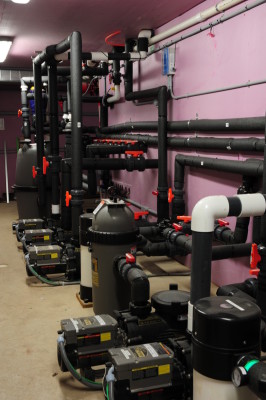 [7]
[7]Furthermore, to minimize heat loss in the spa and reduce electricity consumption, the spa’s shell should be insulated. The greater the temperature difference is between the spa water and the outside environment, the more practical and beneficial the insulation becomes. Insulating all of the plumbing lines associated with the spa (or at least the return line from the heater) can help reduce operating costs for the owner.
The most cost-effective method for increasing a spa’s energy efficiency is to use a spa cover. A cover will minimize heat loss due to evaporation, without it all other insulation is essentially wasted.
A cover can be as simple as a small solar blanker or as complex as a custom-engineered automated design. Its size and weight is determined by the spa’s size. Lifting devices may be required to assist with the installation of large, heavy covers.
Not all spas are alike
Most custom projects installed by spa builders are never one in the same. Each design takes a variety of factors into consideration—from individual client needs to specific site requirements. By thinking outside the standard design ‘box,’ spa builders will see an increase in profits, as well as achieve the ‘wow’ factor their clients are seeking.
 Barry Justus is the owner of Poolscape Inc., a landscape contractor and pool designing and building company based in Burlington, Ont. He can be reached at barry@poolscape.com[8] or by visiting www.poolscape.com[9].
Barry Justus is the owner of Poolscape Inc., a landscape contractor and pool designing and building company based in Burlington, Ont. He can be reached at barry@poolscape.com[8] or by visiting www.poolscape.com[9].
- [Image]: http://poolspamarketing.com/wp-content/uploads/2011/06/spa2.jpg
- [Image]: http://www.poolspas.ca/wp-content/uploads/2015/06/spa15.jpg
- [Image]: http://www.poolspas.ca/wp-content/uploads/2015/06/11561924_2.jpg
- [Image]: http://www.poolspas.ca/wp-content/uploads/2015/06/LED-light-pool.jpg
- [Image]: http://www.poolspas.ca/wp-content/uploads/2015/06/spa20.jpg
- [Image]: http://www.poolspas.ca/wp-content/uploads/2015/06/portable-spa-built-in.jpg
- [Image]: http://www.poolspas.ca/wp-content/uploads/2015/06/spa22.jpg
- barry@poolscape.com: mailto:barry@poolscape.com
- www.poolscape.com: http://www.poolscape.com
Source URL: https://www.poolspamarketing.com/trade/creating-unique-concrete-therapy-pools/